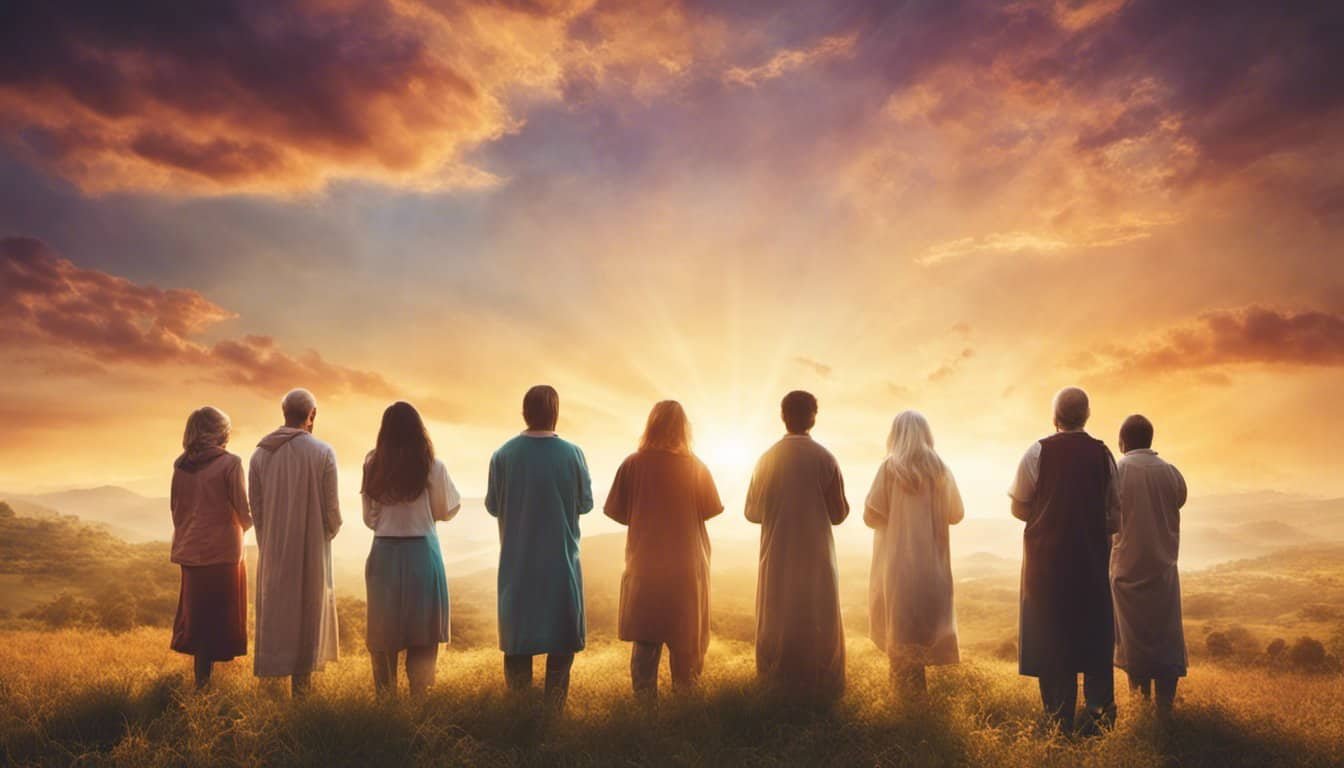Natural disasters impact communities around the world, often leaving devastation and despair. For many Christians, these events provide an opportunity to live out their faith by offering both relief and hope to those affected.
The Christian response to natural disasters combines practical support with empathy, aiming to heal both physical and emotional wounds.


Faith plays a crucial role in how individuals and churches respond during these challenging times.

By coming together, Christians can provide not only resources but also spiritual comfort to those in need. Through prayer and action, they demonstrate that hope can emerge even amid the darkest situations.
In this article, the focus will be on how Christians can effectively respond to natural disasters, highlighting both immediate actions and long-term strategies for building resilience.
The journey from disaster to recovery involves compassion, support, and a shared commitment to helping others.
Key Takeaways
- Christians provide both practical aid and emotional support during disasters.
- Community involvement fosters hope and resilience in the face of hardship.
- Building a prepared and caring community can make a significant difference.
Understanding Natural Disasters
Natural disasters cause significant damage and can greatly impact communities. Understanding their causes and categories helps people prepare and respond effectively. Here are key points to consider.
Defining Disasters
Natural disasters are extreme events caused by natural processes. They can lead to destruction, loss of life, and displacement of people. Examples include hurricanes, earthquakes, tornadoes, flooding, tsunamis, and wildfires.
These disasters often occur suddenly and can disrupt daily life. For instance, hurricanes bring strong winds and heavy rains. Earthquakes can shake the ground without warning. Understanding these events allows communities to be better prepared for potential impacts.
Categories of Natural Disasters
Natural disasters fall into different categories based on their characteristics. Below are some common types:
Meteorological Disasters
- Hurricanes: Powerful storms with strong winds and heavy rains.
- Tornadoes: Violently rotating columns of air that can cause destruction.
Geological Disasters
- Earthquakes: Sudden shaking of the ground caused by movement of tectonic plates.
Hydrological Disasters
- Flooding: Overflowing of water onto normally dry land, often caused by heavy rainfall.
- Tsunamis: Large ocean waves triggered by underwater earthquakes.
Wildfires
- Fires that spread rapidly through forests or grasslands, often due to dry conditions.
Each category has unique challenges, and recognizing these differences is essential for adequate preparation and response.
Theological Perspectives on Disaster

This section explores how different theological views address the issue of natural disasters. It discusses the role of God in such events and how individuals can find hope amid tragedy.
God and Natural Disasters
Many people wonder about God’s role during natural disasters. Some believe that these events are tests of faith. Others see them as opportunities for growth and reflection.
Scriptures suggest that God is a refuge for those in distress. For example, Psalm 46:1 states, “God is our refuge and strength, an ever-present help in trouble.” This message offers comfort and support during hard times.
Additionally, some theologians argue that disasters can lead believers to a deeper relationship with God. They encourage individuals to lean on their faith and trust in His love. This perspective emphasizes understanding God’s nature as compassionate and loving, even in the face of suffering.
Finding Hope in Tragedy
Amid tragedy, many seek hope as a source of strength. The Christian faith teaches that hope can shine through darkness. The love of Christ plays a significant role in this.
In times of crisis, communities often come together to support one another. Acts of kindness can reflect the Christian calling to help those in need. Many churches mobilize to provide relief and comfort, illustrating the importance of collective action in healing.
This response not only aids those affected but also reinforces the belief in salvation through community and faith. The idea that God transforms suffering into hope offers encouragement to those facing challenges. By trusting in God’s plan, believers many find peace even when circumstances seem dire.
Church’s Role in Disaster Response
The church plays a vital role in responding to natural disasters by providing relief, spreading hope, and mobilizing communities. Through organized efforts, churches meet immediate needs and share the Gospel in ways that resonate with those in distress.
Providing Relief
Churches are often at the forefront of disaster relief. They offer food, shelter, and medical assistance to those affected. Organizations like Samaritan’s Purse and The Salvation Army work alongside local congregations to distribute supplies.

Volunteers from churches frequently step up to help in these efforts. They cook meals, collect donations, and assist with cleanup. This hands-on approach not only addresses urgent needs but also shows the community that they are not alone.
Through partnerships with other relief organizations, churches can make a significant impact. They help to organize drives for essential items like clothing and hygiene products.
Spreading the Gospel Through Action
In times of crisis, the church can share the good news through compassionate action. By helping others, they embody the teachings of Jesus, showcasing love and kindness.
When church members serve those in need, they create opportunities for conversations about faith. This can lead to deeper connections and encouragement for those who are struggling.
Churches often share messages of hope and healing during these times. This can be through prayer, counseling, or outreach events. Their presence provides spiritual support as well as physical aid.
Global Church and Local Church Responses

Both global and local churches work together during disasters. Local congregations are quick to mobilize, while global church bodies can provide necessary funding and resources.
For example, when a natural disaster strikes, local churches assess their community’s needs. They may call upon larger networks for additional support. Global organizations can then send funding or supplies to assist.
Churches also train volunteers in disaster preparedness. This enables members to respond quickly when emergencies occur. They learn how to provide help effectively, making a real difference in people’s lives.
By coming together, the global church demonstrates unity and hope. This collaboration helps communities rebuild and restore their lives after devastation.
Practical Ways to Help


There are many effective ways to offer support during natural disasters. Each approach can make a meaningful difference in the lives of those affected. Below are some important actions individuals can take to help disaster victims and their communities.
Volunteering Opportunities
Volunteering is a powerful way to provide immediate support to those in need. Many organizations, like the Red Cross, always look for willing hands to assist during disasters.
Volunteers can help with various tasks, such as distributing food, providing medical assistance, or offering emotional support.
Disaster response teams often host training sessions for new volunteers. This training teaches essential skills for safe and effective disaster relief. It’s a great chance to learn about the challenges disaster victims face and how to meet their needs.
Participating in community-based efforts, such as local cleanup or rebuilding projects, is also beneficial. These initiatives foster unity and encourage teamwork among volunteers.
Donations and Financial Support

Donating money or supplies can have a significant impact. Financial contributions help organizations respond quickly and effectively to emergencies. They often use this funding to procure essential items, such as food, clean water, and medical supplies.
Many charities provide options to donate specific items, like toiletries, clothing, or blankets. These items can provide comfort and safety to affected individuals.
It’s crucial to research organizations before donating. Ensure they have a solid reputation for using funds wisely. Trusted organizations will openly share how they allocate donations to maximize their effectiveness in disaster response.
Creating Awareness and Advocacy
Raising awareness about natural disasters and their impact can lead to increased support for victims. Sharing information through social media or local gatherings helps educate the community. People thrive when they understand the importance of solidarity during tough times.
Advocacy plays a big role too. Individuals can participate in campaigns that urge local authorities and governments to improve disaster preparedness. This can lead to better infrastructure and response plans for future events.

Those who share their experiences during a disaster can inspire others to join in efforts. Personal stories can resonate and unite communities, motivating them to make a change together.
Providing Shelters and Safety
Ensuring safe spaces for those affected by disasters is essential. Churches, schools, and community centers often serve as temporary shelters.
These locations provide vital refuge when homes are damaged or unsafe. They usually offer basic necessities like food, water, and medical care.
Local organizations often coordinate efforts to set up these shelters quickly. They work to ensure victims have a safe place to rest and recover.
Volunteers can help manage these shelters and ensure fair distribution of resources. Their presence promotes safety and comfort during chaotic times. Providing a supportive environment can greatly aid in the emotional healing of disaster victims.
Emotional and Spiritual Care


Emotional and spiritual care is essential for individuals affected by natural disasters. It provides comfort, promotes healing, and fosters community support. Through compassionate actions and outreach, faith-based organizations shine a light of hope in dark times.
Offering Comfort
In times of crisis, offering comfort means being present with those who are suffering. Faith leaders and volunteers play a vital role by providing a listening ear and a warm embrace. They help individuals feel valued and understood during their pain.
Support options include prayer circles and counseling sessions that focus on emotional needs. These gatherings encourage participants to share their stories and feelings, creating a safe space for healing. Through these actions, survivors often find strength and solace.
Faith-based organizations, like the Billy Graham Rapid Response Team, provide trained volunteers who help people cope emotionally. Their work centers on fostering hope and resilience, demonstrating that healing can begin even amid disaster.
Healing and Reconciliation

Healing after a disaster is not just physical; it’s deeply emotional and spiritual. Many survivors seek reconciliation with their past and a renewed sense of purpose. Spiritual guidance plays a significant part in this journey.
Workshops and retreats offer a place for individuals to reflect, heal, and reconnect with their faith. These environments encourage dialogue and help people confront their pain head-on. This process often brings individuals closer to their communities and their spirituality.
Organizations also provide resources for therapy that encompasses both mental health and spiritual needs. This dual focus allows individuals to experience true healing and reconciliation, reminding them they are not alone in their struggle.
The Power of Community Support
Community support is vital for recovery after natural disasters. It helps foster a sense of belonging and strength among survivors.
In a supportive environment, individuals can share their experiences and find hope.

Churches and community groups often mobilize quickly to provide assistance. They organize food drives, shelters, and mental health resources. These initiatives create a network of care that offers practical help and emotional support.
Having a strong community presence reminds individuals that they are part of a larger whole. This interconnectedness not only helps with immediate needs but also nurtures long-term healing and resilience. Through collective efforts, communities can thrive even after facing deep challenges.
Disaster Preparedness and Mitigation

Effective disaster preparedness and mitigation can greatly reduce the impact of natural disasters on communities. It involves educating individuals and building stronger, more resilient neighborhoods. These steps empower people to respond effectively when disasters occur.
Education and Training
Education is vital for disaster preparedness. Communities should conduct regular workshops to teach members about potential risks and the actions to take.
These trainings can cover topics such as creating emergency plans, assembling disaster kits, and understanding evacuation routes.
Organizations can partner with local schools and community centers to host these training sessions. Providing hands-on activities, like first aid training, helps reinforce learning. It is essential to keep everyone informed about updates to disaster protocols.
Key Components for Education:
- Community workshops
- Emergency plan development
- First aid training
By equipping individuals with knowledge, communities can increase their resilience in the face of natural disasters.
Building Resilient Communities
Building resilient communities involves creating infrastructures that can withstand disasters and ensuring that everyone is included in recovery efforts. This can be achieved through strengthening buildings and establishing communication lines.
Local governments should focus on developing updated building codes that require construction to meet safety standards. This includes retrofitting older buildings to withstand earthquakes or floods.
Collaboration among community members is crucial for success. Engaging in drills and simulations helps everyone prepare for real situations.
Strengthening Community Resilience:
- Upgraded building codes
- Regular emergency drills
- Effective communication networks
By working together and taking steps to enhance safety, communities can better recover from disasters and provide hope for the future.
Case Studies of Christian Response
Christian groups have played a vital role in responding to natural disasters across the United States and around the world. They provide both physical aid and emotional support to those in need. Here are some key examples of how Christian organizations have stepped up during difficult times.
Hurricane Recovery in Florida and Georgia
In the wake of hurricanes in Florida and Georgia, many Christian organizations mobilized quickly. Churches opened their doors as shelters for those displaced by the storms. Groups like the Southern Baptist Convention often provide meals, clothing, and shelter.
Volunteers help with debris cleanup and house repairs. They also offer emotional support, reminding those affected that they are not alone. Faith-based organizations often partner with local governments to ensure aid reaches those who need it most.
Tornado Relief in South Carolina and Virginia
Southern states like South Carolina and Virginia have experienced devastating tornadoes. Christian relief efforts have been crucial in these situations.
For instance, local churches often organize food drives and supply distribution for affected families. They send teams of volunteers to clean up wreckage and assist families in rebuilding their homes.
These groups focus not just on physical needs but also on restoring hope and community spirit among those impacted by the disasters.
International Responses to Tsunamis and Earthquakes
When tsunamis and earthquakes strike, Christians around the world respond with compassion and action. Organizations such as World Vision and Compassion International lead relief efforts in affected areas.
They provide food, water, medical care, and shelter for survivors. Churches in disaster-hit regions often serve as community hubs for aid distribution. Additionally, these groups emphasize long-term recovery, helping communities rebuild and regain their strength through faith-based programs.
Looking Forward: Building Hope and Resilience

In the face of natural disasters, communities find strength and comfort through rebuilding efforts. Emphasizing recovery helps people not only to cope but also to grow. Stories of hope serve as powerful reminders of human resilience in difficult times.
Sustained Recovery Efforts
Recovery after a disaster doesn’t happen overnight. It requires ongoing support and commitment from both individuals and organizations.
Churches often play a central role in these efforts. They organize relief activities, collective fund drives, and volunteer programs.
Key elements include:
- Providing physical support such as food and shelter.
- Offering emotional assistance through counseling and prayer.
- Creating community programs to rebuild a sense of normalcy.
Such sustained efforts bring hope to those affected. They allow individuals to see a brighter future, reminiscent of the reassurance found in Psalm 46: “God is our refuge and strength.” This promise inspires action and fosters resilience.
Inspiring Stories of Hope and Strength
Within the hardships, there are countless stories that uplift spirits.
For instance, families who lost their homes often come together to support one another. Through shared experiences, they build stronger connections, emphasizing their collective strength.
- A church group might share meals with displaced families.
- An individual might volunteer to help rebuild homes.
These acts of kindness illustrate the human spirit’s ability to rise above adversity.
Such stories resonate deeply, showcasing that recovery is possible through community unity and faith. These narratives not only inspire others but also reflect the hope that can flourish even in challenging times.












